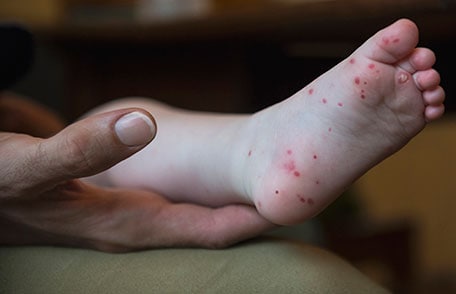How Hand, Foot, and Mouth Disease Spreads
Hand, foot, and mouth disease (HFMD) spreads easily through:
- Person-to-person contact.
- Droplets made when a person who is sick with HFMD sneezes, coughs, or talks.
- Contact with contaminated surfaces and objects.
Is hand, foot, and mouth disease contagious?
Yes. HFMD is caused by viruses. A person infected with one of these viruses is contagious, which means that they can pass the virus to other people.
If someone is sick with HFMD, the virus can be found in their:
- Nose and throat secretions, such as saliva, drool, or nasal mucus
- Fluid from blisters
- Feces (poop)
People with HFMD are usually most contagious during the first week that they are sick. However, people can still sometimes spread the virus to others for days or weeks after symptoms go away, or even if they have no symptoms at all.
How do you get hand, foot, and mouth disease?

- Contact with droplets that contain the virus made when a person sick with HFMD coughs, sneezes, or talks.
- Touching an infected person or making other close contact with them, such as kissing, hugging, or sharing cups or eating utensils.
- Touching an infected person’s poop, such as changing diapers, and then touching your eyes, nose, or mouth.
- Touching objects and surfaces that have the virus on them, like doorknobs or toys, and then touching your eyes, nose, or mouth.
Although rare, you can also get the viruses by swallowing recreational water, like in swimming pools. This can happen if the water is not properly treated with chlorine and becomes contaminated with the poop from a person who has HFMD.
Is hand, foot, and mouth disease is common?
Yes. HFMD is common and in the United States occurs mostly in the summer and fall, but you can get it any time of year.
What viruses cause hand, foot, and mouth disease?
HFMD is caused by viruses that belong to the enterovirus family:
- Coxsackievirus A16 is typically the most common cause of HFMD in the United States. Other coxsackieviruses can also cause the illness.
- Coxsackievirus A6 can also cause HFMD and the symptoms may be more severe.
- Enterovirus 71 (EV-A71) has been associated with cases and outbreaks in East and Southeast Asia. Although rare, EV-A71 has been associated with more severe diseases such as encephalitis (swelling of the brain).
Can animals get hand, foot, and mouth disease?

No. Animals such as cattle, pigs, sheep, and goats can get foot and mouth disease (or hoof-and-mouth disease), which is different from hand, foot, and mouth disease (or HFMD).
Visit the USDA website to learn more about foot and mouth disease

Wash your hands often for at least 20 seconds to stop germs from spreading.


